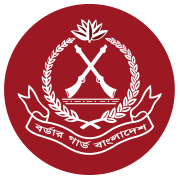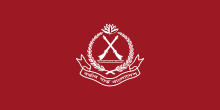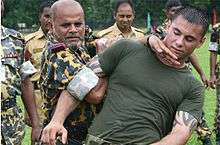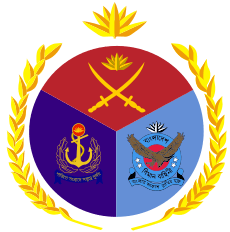Border Guards Bangladesh
| Border Guards Bangladesh | |
|---|---|
|
বর্ডার গার্ড বাংলাদেশ বাংলাদেশ সীমান্ত রক্ষক | |
 Monogram of BGB | |
| Active | 1795–present |
| Country |
|
| Allegiance | Bangladesh |
| Branch | Border guards |
| Type | Paramilitary |
| Size | 50,000[1] |
| BGB HQ | Pilkhana |
| Nickname(s) | BGB |
| Patron | President |
| Anniversaries | 26 March |
| Engagements |
World War I World War II Indo-Pakistani War of 1965 Bangladesh Liberation War 2001 Bangladeshi-Indian border skirmish 2015 Bangladesh–Arakan Army border clash |
| Decorations |
1. Bir Sreshtho 2. Bir Uttom 3. Bir Bikrom 4. Bir Protik |
| Battle honours |
Bengal-British war World War 2 Indo-Pakistani war of 1965 Bangladesh Liberation War Bangladesh-India Border Clash |
| Website | http://www.bgb.gov.bd |
| Commanders | |
| Director General | Major General Shafeenul Islam |
| Insignia | |
| Flag of Border Guard Bangladesh |
 |
The Border Guards Bangladesh (Bengali transliteration: বর্ডার গার্ড বাংলাদেশ; translated from English: বাংলাদেশ সীমান্ত রক্ষক; BGB), formerly known as the Bangladesh Rifles,[2] is the oldest uniformed force in Bangladesh. It is a paramilitary force under the Ministry of Home Affairs. BGB is primarily responsible for the border security of the country, in Bangladesh the force is known as "The Vigilant Sentinels of the National Frontier".[3] The Present Director General is Maj. Gen. Shafeenul Islam.[4]
Border Guards Bangladesh, as a paramilitary force, is entrusted with the responsibility to defend the 4,427 kilometres (2,751 mi) border of Bangladesh.[5] BGB boasts a military history spanning over two centuries.[6] During peacetime this force is also responsible for anti-smuggling operations, investigating cross border crime and extending governmental authority to remote and isolated areas. From time to time BGB has also been called upon to assist the administration in the maintenance of internal law & order, relief and rehabilitation work after any kind of natural disaster.[7][8] During wartime BGB comes under the control of the Ministry of Defence as an auxiliary force to the Bangladesh Army.
History
Formation and pre 1947
Ramgarh Local Battalion
The Ramgarh Local Battalion was established on 29 June 1795 at the city of Ramgarh,[9] consisting of 486 personnel, as the "Frontier Protection Force", under the command of the East India Company.[10] Later the force was converted into a paramilitary unit with its own name (Ramgarh Local Battalion) and uniform. At that time its primary responsibility was to suppress insurgent activities around the Ramgarh area.
Special Reserve Company
During 1799, the force established its first camp at Pilkhana, where the headquarters remain to this day. The camp unit then was known as "Special Reserve Company".
Frontier Guards
The Ramgarh Local Battalion was renamed as the "Frontier Guards" and remained so for thirty years from 1861 to 1891.
Bengal Military Police
From 1891 till 1920, the Frontier Guards were re-organized and re-equipped with modern weapons and renamed once again as the "Bengal Military Police".[10] Commanded by a Subedar (Senior Warrant Officer), the BMP had four companies located in Dhaka, Dhumka and Gangtok. This force also participated in the First World War.[11]
Eastern Frontier Rifles
The BMP was reorganised yet once again and renamed as the "Eastern Frontier Rifles" in 1920. Its primary task was to protect the borders. It also took part in numerous military operations during the Second World War.[11]
East Pakistan Rifles
After the partition of India, "Eastern Frontier Rifles" was re-grouped and renamed as the "East Pakistan Rifles" in 1947.[12] It was the primary border protection force of the then East Pakistan. A number of Metropolitan Armed Police of Calcutta and some 1,000 ex-soldiers of West Pakistan merged into this force. Officers from the army were transferred to command and reorganise EPR. In 1958, it was also assigned the anti-smuggling duties on top of its primary role as the border guards. Major Tufail Mohammad was awarded the highest military award of Pakistan, 'Nishan-e-Haider', for his action in the Laksmipur Operation.[13][14]. In 1965 India Pakistan war this force fought valiantly and successfully in a number of skirmishes in Lathitila, Dohogram, Laksmipur, Assalong and Boroibari.

Bangladesh Liberation War 1971
During the Bangladesh Liberation War of 1971 nearly nine thousand of the members of the East Pakistan Rifles (EPR) turned against the Pakistan Army, following the Declaration of Independence of Bangladesh on 26 March 1971 at Kalurghat Radio Station, Chittagong. Eight hundred and seventeen EPR personnel were subsequently reported as being killed in action. East Pakistan Rifles was the border security and anti-smuggling force stationed in what was to become independent Bangladesh. It was commanded by Junior Commissioned Officers (JCO) at the company level. All EPR companies were based within 5 miles of the international boundary. There were two senior commissioned officers, seconded from the Pakistan Army in command of each Wing (battalion) of the EPR. In March 1971, there were 12 EPR Wings. The entire force according to CIA estimates had 10 thousand enlisted personal.[15]
At the outbreak of Bangladesh Liberation war the EPR were the first Bengali military unit to defect from the Pakistan forces; moving to Sholashahar and the main military cantonment, while calling on all Bengali soldiers to join them. Reportedly West Pakistani officers serving with the EPR were executed by their Bengali colleagues. On 26 March, the Pakistan Army sent troops to suppress the EPR. The EPR ambushed them but the Pakistanis managed to encircle them. As a result, the EPR took heavy losses at Kumira. According to Captain Rafiq, "This ambush by the E.P.R. troops at Kumira was the first direct action against the enemy in the history of our liberation war."[16]
Bangladesh Rifles
On 29 January 1972, the East Pakistan Rifles was renamed the Bangladesh Rifles with the officers seconded from Bangladesh Army.[17] Bangladesh Rifles initially had 9 thousand personal in 1971 which by 1973 had increased to 20 thousand.[18] Bangladesh Rifles and Indian Border Security Forces exchanged fired near the Comilla-Tripura border throughout the entire month of December 1979.[19] In 1996 Bangladesh Rifles personal had grown to 69 thousand.[20]
Bangladesh–India border clashes 2001
The 2001 Indian–Bangladeshi border conflict took place in the third week of April 2001 between companies of the Bangladesh Rifles and the Indian Border Security Force on the poorly marked international border between the two countries. This was the worst border conflict Bangladesh was involved in since Independence. The 16–19 April fighting took place around the village of Padua (known as Pyrdiwah in India), which adjoins the Indian state of Meghalaya and the Timbil area of the Bangladesh border in the Sylhet district. In that area, 6.5 kilometres of the border have remained in dispute for the past 30 years. The trigger for the clash appears to have been an attempt by Indian forces to construct a footpath from an army outpost in Padua across a disputed territory some 300 metres wide to Indian Meghalaya. On 15 April 2001, the BDR attacked and captured Pyrdiwah village. Both sides later deescalated and returned to the original positions on the border. This incident left 16 Indian Border Security Force paramilitary men dead and 3 Border Guards Bangladesh men dead with 5 other BGB troops injured.[21]
BDR Mutiny 2009
On 25 February 2009, regular BDR soldiers mutinied against their officers who were seconded from the Bangladesh Army.[22] The mutiny took when senior commanders were in Dhaka for convocation or durbar.[23][24] A total of 74 people were killed in the Mutiny.[25] Many senior officers were killed, including almost the entire higher echelon of the command structure – about 57 army officers who were present in the Bangladesh Rifles' headquarters in the capital Dhaka. These included the Director General of the BDR. The soldiers mutinied due to reasons which largely remain unknown, though resentment at officers being seconded from Bangladesh army and allegations of corruption are believed to have been among the causes.[26][27][28][29]

After 30 hours, being surrounded by Bangladesh Army tanks, the mutineers surrendered with about 6,000 of them taken under arrest, ending the mutiny.[30] On November 2013, Bangladesh sentenced 152 mutineers from Bangladesh Rifles to death.[31]
Border Guards Bangladesh
In the aftermath of the mutiny, the Bangladesh Rifles was reorganised with new recruits. The force is still commanded by senior officers seconded from the Bangladesh Army. The Bangladesh Rifles have gone through some fundamental changes since 2010. It was officially renamed as the Border Guard Bangladesh (BGB) on 23 January 2011 and reorganised with fresh recruits. The BGB has a current strength of 50,000[1] organised into 61 battalions and largely located in numerous border outposts (B.O.P.). Administration staff and most of the officer corps are trained by and seconded from the Bangladesh Army. However, there are around 100 officers promoted from within the force itself. The border guards also formed their own intelligence unit.[32] The Border Guard Bangladesh Act, 2010 increased the maximum punishment for mutiny from 7 years in jail to the death penalty.[33]
Bangladesh–Myanamr border skirmish 2015
On 28 May 2014, during a routine patrol of the BGB in Bandarban District, along the Bangladesh-Myanmar border, Myanmar Border Police opened indiscriminate firing on the BGB patrol. The incident took the life of Border Guard Corporal Mizanur Rahman 43. The body of the slain soldier was then carried over the border by Myanmar Border Police. On 30 May upon request of the Myanmar Ambassador to Bangladesh a BGB team was waiting near border pillar no. 52 for identification of the dead body which was proposed by the Myanmar side. However, to the complete surprise of the BGB, Myanmar border forces suddenly started firing on the waiting BGB team without any provocation resulting in the BGB team returning fire. Both sides deescalated and agreed to a cease fire and on the following day Myanmar returned the dead body of BGB Corporal Mizanur Rahman. Bangladesh's Ministry of Foreign Affairs had protested strongly to the Burmese ambassador over the unprovoked eruption of gunfire by Burmese border troops.[34][35]
Bangladesh–Arakan Army border clash 2015
On 26 August 2015 the Arakan Army, A separatist group in Myanmar, attack a BGB patrol in Boro Modak, Thanchi, Bandarban. Two border guards were injured in the attack. On 11 May 2015 the BGB camp in Thanchi came under mortar fire, BGB retaliated by firing two rounds towards the border.[36] Indian BSF agreed to allow BGB to use BSF roads in India to patrol the border on 1 August 2016.[37] On 15 November 2016 Border Guards Bangladesh stopped 86 Rohingyas from entering Bangladesh on two boats.[38] On 6 February 2017 BGB protested with their counterparts in Myanmar Border Guard Police, after they shot and killed a Bangladeshi fisherman in the Naf River.[39] BGB deployed its first female border guards on 24 February 2017 in the Dinajpur border area.[40] BGB and Myanmar Police Force came to an agreement on 6 April 2017 to remove mines from the border area.[41]
Decorations
The then-East Pakistan Rifles joined the Bangladesh War of Independence on the side of Mukti Bahini in 1971. One hundred and forty one members earned gallantry awards for their outstanding contribution to the liberation war of Bangladesh. Naik Nur Mohammad Sheikh and Naik Munshi Abdur Rouf posthumously earned the Bir Sreshtha, which is the highest gallantry award of the nation.[42][43] 8 earned the Bir Uttom. 40 earned the Bir Bikram and 91 earned the Bir Protik awards.
After independence, on 3 March 1972 the force had been renamed as Bangladesh Rifles. As a mark of recognition for the courage and bravery of its members, BDR introduced 'Bangladesh Rifles Podok' in 1985 and President Rifles podok' in 1989.[44][45] 21 members had received the 'Bangladesh Rifles Podok' 29 had received the 'President Rifles Podok'.
Responsibilities
- Patrolling and securing the border
- Investigating cross border crimes
- Anti-smuggling Operations
- Counter Terrorism
- Domestic law enforcement during national emergencies
- Acting as a reserve force under M.O.D. during war
List of Chiefs of Border Guards Bangladesh
Organization
The BGB is commanded by a Major General ranked Bangladesh Army officer. The BGB administration and most of the officer corps are trained and deputed from the Bangladesh Army. There are, however, around 100 officers who are promoted from within the force itself. They can be promoted as high as Deputy Director (Equivalent to Major in Bangladesh Army). Its current strength is 50,000[1] structured along 61 battalions and numerous border outposts (B.O.P.), mostly along the borders. BGB is organised into a central headquarters and 4 regional headquarters. Under the regional headquarters there are 16 sectors. Each sector is commanded by a Colonel.
- Central HQ: Pilkhana, Dhaka[3]
- Director-General (DG):
- Additional Director-General (Addl DG) HQ:
- Additional Director General (Operations and Training):
- Additional Director General (Administration):
- Additional Director General (Medical)
- Deputy Director General (Records)
- Deputy Director General (Communications)
- Sector Command (Dhaka):
- 13th BGB Battalion
- 24th BGB Battalion
- 36th BGB Battalion
- 44th BGB Battalion
- North Eastern Regional HQ: Sarail
- Sector Command (Comilla):
- 12th BGB Battalion
- 19th BGB Battalion
- 33rd BGB Battalion
- Sector Command (Mymensingh):
- 6th BGB Battalion
- 16th BGB Battalion
- 27th BGB Battalion
- Sector Command (Srimangal):
- Sector Command (Sylhet):
- 5th BGB Battalion
- 8th BGB Battalion
- 14th BGB Battalion
- 38th BGB Battalion
- Sector Command (Comilla):
- North Western Regional HQ: Rangpur
- Sector Command (Dinajpur):
- 2nd BGB Battalion
- 3rd BGB Battalion
- 20th BGB Battalion
- 40th BGB Battalion
- Sector Command (Rajshahi):
- 37th BGB Battalion
- 39th BGB Battalion
- 43rd BGB Battalion
- 46th BGB Battalion
- Sector Command (Rangpur):
- 25th BGB Battalion
- 31st BGB Battalion
- 7th BGB Battalion
- 45th BGB Battalion
- Sector Command (Thakurgaon):
- Sector Command (Dinajpur):
- South Eastern Regional HQ: Halishahar
- Sector Command (Baghaichari):
- Sector Command (Bandarban):
- 10th BGB Battalion
- Sector Command (Chattagram):
- 15th BGB Battalion
- 17th BGB Battalion
- 28th BGB Battalion
- 42nd BGB Battalion
- Sector Command (Khagrachari):
- 9th BGB Battalion
- 11th BGB Battalion
- 21st BGB Battalion
- 29th BGB Battalion
- 30th BGB Battalion
- 47th BGB Battalion
- Sector Command (Rangamati):
- 1st BGB Battalion
- 4th BGB Battalion
- 18th BGB Battalion
- 26th BGB Battalion
- South Western Regional HQ: Jessore
- Adhoc Region HQ - Ramu
- Director-General (DG):
Equipment
| Name | Type | Caliber | Notes |
|---|---|---|---|
| Type 92 | Semi-automatic pistol | 9mm | Standard issue sidearm. |
| Type 54 | Semi-automatic pistol | 7.62mm | Chinese version of Soviet Tokarev TT-33 in service with all branches of armed, para-military and law enforcement services. |
| BD-08 | Assault rifle | 7.62mm | Produced under license by BOF. |
| Type 85 | Sniper rifle | 7.62mm | |
| BD-08 | Light machine gun | 7.62mm | Produced under license by BOF. |
| RPD | Light machine gun | 7.62mm | |
| Rheinmetall MG 3 | General purpose machine gun | 7.62mm | |
| Type 63-1 | Mortar | 60 mm | Being replaced by Type 93. |
| M 29A1 | Mortar | 81mm | |
| Otokar Cobra | LAV | A 4x4 wheeled LAV. 17 Received in 2008. 7 are in use with Bangladesh Police since 2007. | |
| Akshay class | Coastal Patrol Craft | 1 ship (BGB Shah Jalal)[46] |
Future modernization programme
BGB has adopted a long term modernization plan named "BGB Goal 2041" in 2017. The plan intends to make BGB a well-trained, well-equipped and technologically advanced force.
In short terms, BGB plans for structural and manpower expansion. A new region (equivalent to division) will be raised in Ramu of Cox's Bazar. Three new sectors (equivalent to brigade) will be raised at Ali Kadam of Bandarban, Naogaon and Jessore. Eight new battalions will be formed at Jhikargacha of Jessore, Meherpur, Khagrachari, Boro Mowdok of Bandarban, Gazipur, Narayanganj and Kulaura of Maulavibazar. Two riverine battalions will be raised in BGB at Nildumur of Shatkhira and Teknaf of Cox's Bazar. They are the first two units of BGB who will be able to operate in riverine borders and chars (River island). The number of personnel will be increased from 50000 to 65000 soon. 124 Border Out Posts (BOP) and 70 heli-support BOPs are being set up in the border areas of hilly districts along the border with Myanmar. 128 Border Sentri Posts (BSP) are being constructed between the distant BOPs. BGB members ae being equipped with bulletproof vests and ballistic helmet.[47]
A Quick Response Force (QRF) will be established for BGB. The force will work to supply modern arms and ammunition swiftly to border points in case of any emerency.[48] For smooth operation in the border areas, border roads are being constructed. In BGB day 2017, prime minister said that the government has undertaken a plan to construct a total of 3,167 km ring road across the borders with India and Myanmar.[47]
BGB intends to go three dimnsional as per the plan. Bangladesh government has already approved the proposal for buying two Mi-171E helicopters from Russia at a cost of Tk. 355.10 crore.[49] However, Bangladesh Air Force pilots will fly the helicopters initially. A heliport with hanger is being set up at Baitul Izzat in Chittagong. Eventually, BGB plans to have four aviation wings.[50]
To effectively monitor the border, BGB plans to add modern technology to the border management. The plan is to set up cameras, night vision goggles and infrared sensors throughout the border. BGB plans to achieve 3I (Information, Identification, Intervention) capabilities in the border in long term. Having Radar and Satellite monitoring facilities in the border are also planned.
References
- 1 2 3 "বিজিবিতে আরো ১৫ হাজার জনবল নিয়োগ দেওয়া হবে". Kaler Kantha. 2 August 2017. Retrieved 13 August 2017.
- ↑ "Bangladesh Rifles to get new name". BBC News. 1 March 2010. Retrieved 26 April 2010.
- 1 2 Bangladesh
- ↑ "Maj Gen Shafeenul new DG of BGB". The Daily Star. Retrieved 24 March 2018.
- ↑ Schendel, Willem van (2005-01-01). The Bengal Borderland: Beyond State and Nation in South Asia. Anthem Press. p. 73. ISBN 9781843311454.
- ↑ Kumar, Satish (2012-02-27). India’s National Security: Annual Review 2009. Routledge. ISBN 9781136704901.
- ↑ "Dhaka jail's security boosted, BGB deployed". The Daily Star. 2015-11-21. Retrieved 2017-04-13.
- ↑ "BGB man shot dead in Comilla". The Daily Star. 2013-11-26. Retrieved 2017-04-13.
- ↑ South Asia Defence and Strategic Year Book. Panchsheel. 2009-01-01. p. 273.
- 1 2 Rahman, Syedur (27 April 2010). Historical Dictionary of Bangladesh. Scarecrow Press. p. 44. ISBN 9780810874534.
- 1 2 Chowdhury, Tamina M. (2016-11-10). Indigenous Identity in South Asia: Making Claims in the Colonial Chittagong Hill Tracts. Routledge. ISBN 9781317202929.
- ↑ Schendel, Willem van (2005-01-01). The Bengal Borderland: Beyond State and Nation in South Asia. Anthem Press. p. 108. ISBN 9781843311454.
- ↑ "Maj. Tufail Shaheed remembered on his 58th death anniversary - Pakistan - Dunya News". dunyanews.tv. Retrieved 2017-04-24.
- ↑ "Maj Tufail Shaheed remembered". The Nation. Retrieved 2017-04-24.
- ↑ "East Pakistan had many pro-Pakistani army officers | Dhaka Tribune". Dhaka Tribune. 2017-03-09. Retrieved 2017-04-24.
- ↑ (Major Rafiq: A Tale of Millions, Page 56 and Aberar Shongram Shadhinotar Shongram, P:135, by: Lieutenant Colonel Abu Osman Chowdhury)
- ↑ Rahman, Syedur (2010-04-27). Historical Dictionary of Bangladesh. Scarecrow Press. p. 45. ISBN 9780810874534.
- ↑ USA, IBP (2012-03-03). Bangladesh Country Study Guide Volume 1 Strategic Information and Developments. Lulu.com. p. 161. ISBN 9781438773896.
- ↑ Times, Special To The New York (1979-12-03). "India and Bangladesh Trade Fire in Border Dispute". The New York Times. ISSN 0362-4331. Retrieved 2017-04-24.
- ↑ Whyte, Mariam; Yong, Jui Lin (2009-09-01). Bangladesh. Marshall Cavendish. p. 38. ISBN 9780761444756.
- ↑ "Fresh Bangladesh border clash". BBC. 19 April 2001. Retrieved 3 April 2016.
- ↑ Manik, Julfikar Ali; Sengupta, Somini (2009-02-25). "Army's Border Guards Rebel in Bangladesh". The New York Times. ISSN 0362-4331. Retrieved 2017-04-24.
- ↑ "8 years on, gruesome BDR mutiny still in memory | Dhaka Tribune". Dhaka Tribune. 2017-02-25. Retrieved 2017-04-24.
- ↑ Sobhan, Zafar (2009-03-02). "After the Mutiny, Questions About Bangladesh's Army". Time. ISSN 0040-781X. Retrieved 2017-04-24.
- ↑ Sengupta, Somini (2009-03-13). "Bangladeshi Premier Faces a Grim Crucible". The New York Times. ISSN 0362-4331. Retrieved 2017-04-24.
- ↑ "Archived copy". Archived from the original on 7 March 2014. Retrieved 22 January 2015.
- ↑ "Bangladesh becomes battle zone". BBC. 25 February 2009. Retrieved 3 April 2016.
- ↑ "Bangladesh tries 800 soldiers for bloody 2009 mutiny". BBC News. Retrieved 3 April 2016.
- ↑ "Dozens feared dead in Bangladesh mutiny". CNN. Retrieved 3 April 2016.
- ↑ "Human Rights Watch Report on Bangladesh Rifles Mutiny Trial". Human Rights Watch. 4 July 2012. Retrieved 29 June 2014.
- ↑ Manik, Julfikar Ali; Barry, Ellen (2013-11-05). "152 Bangladeshi Border Guards Get Death Penalty Over Revolt". The New York Times. ISSN 0362-4331. Retrieved 2017-04-24.
- ↑ "BDR to get new name, uniform, intelligence unit". The Daily Star. 2009-08-19. Retrieved 2017-04-13.
- ↑ "Firm fetters for border guards". The Daily Star. 2010-09-20. Retrieved 2017-04-13.
- ↑ "Myanmar returns arms, ammo of slain BGB man". The Daily Star. 2014-06-05. Retrieved 2017-04-13.
- ↑ "Myanmar's border force regrets Mizan's killing". The Daily Star. 2014-06-06. Retrieved 2017-04-13.
- ↑ "Bandarban BGB camp comes under mortar attack". The Daily Star. 2016-05-12. Retrieved 2017-04-13.
- ↑ "India lets BGB use its roads for patrol". The Daily Star. 2016-08-01. Retrieved 2017-04-13.
- ↑ "Coast guards push back 125 Rohingyas". The Daily Star. 2016-11-20. Retrieved 2017-04-13.
- ↑ "Bangladesh national shot dead at Myanmar border". The Daily Star. 2017-02-06. Retrieved 2017-04-13.
- ↑ "First ever female BGB members deployed at Hili Border | Dhaka Tribune". Dhaka Tribune. 2017-02-24. Retrieved 2017-04-24.
- ↑ "BGB, Myanmar cops agree to remove mines from border". The Daily Star. 2017-04-06. Retrieved 2017-04-13.
- ↑ "Rauf, Birsrestha Munshi Abdur - Banglapedia". en.banglapedia.org. Retrieved 2017-04-24.
- ↑ "Sheikh, Birsrestha Nur Mohammad - Banglapedia". en.banglapedia.org. Retrieved 2017-04-24.
- ↑ "Birth of the Phoenix". The Daily Star. 2010-01-02. Retrieved 2017-04-24.
- ↑ "CA asks BDR to plan for creating poll atmosphere". The Daily Star. 2008-03-04. Retrieved 2017-04-24.
- ↑ "BDR-SHAHJALAL - Patrol Vessel - Details and current position IMO 8106472 MMSI 0 | Vessels | VesselFinder". www.vesselfinder.com. Retrieved 2017-04-23.
- 1 2 "PM asks BGB members to be imbued with bonding spirit". The Daily Star. 21 December 2017. Retrieved 21 December 2017.
- ↑ "BGB to introduce Quick Reaction Force". The Independent. 4 August 2017. Retrieved 13 August 2017.
- ↑ "Russian copters to turn BGB into 3-dimensional force". The Independent. 9 October 2018. Retrieved 13 October 2018.
- ↑ "BGB wants aviation wing". The Independent. 13 August 2016. Retrieved 13 August 2017.
| Wikimedia Commons has media related to Border Guards Bangladesh. |
